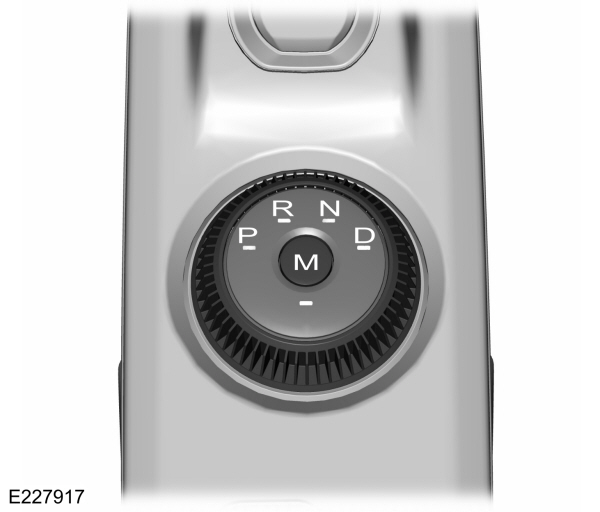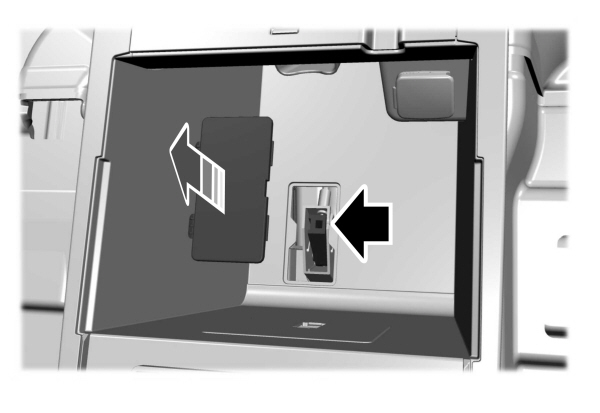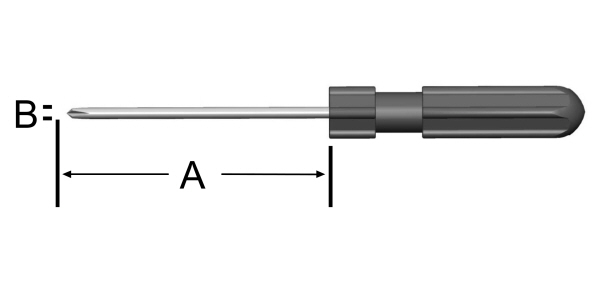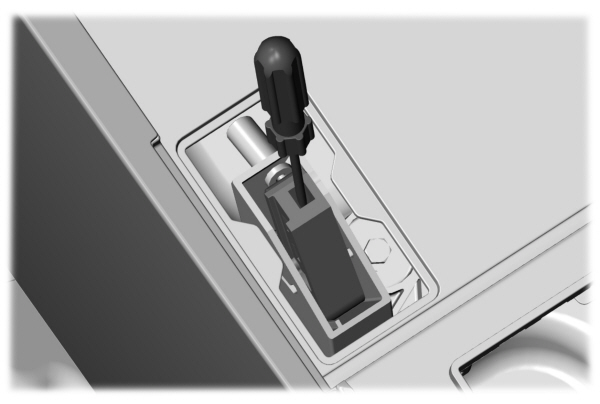This view of the Owner's Manual contains the very latest information, which may vary slightly from the printed Owner's Manual originally provided with your vehicle. It may also describe content that is not on or operates differently on your vehicle. Please consider the Owner's Manual originally provided with your vehicle as the primary source of information for your vehicle.

The information contained in this publication was correct at the time of release.In the interest of continuous development, we reserve the right to change specifications, design or equipment at any time without notice or obligation.No part of this publication may be reproduced, transmitted, stored in a retrieval system or translated into any language in any form by any means without our written permission.Errors and omissions excepted.
Copyright © 2024 Ford Motor Company
Automatic Transmission




 To activate tow mode, use the drive mode switch on the center console. See
Selecting a Drive Mode.
The Tow Mode Feature:
To activate tow mode, use the drive mode switch on the center console. See
Selecting a Drive Mode.
The Tow Mode Feature:



 WARNING:
Apply the parking brake and make sure your vehicle is in park (P). Power the vehicle off and remove the keys or remote control whenever you leave your vehicle. Failure to follow this instruction could result in personal injury or death.
WARNING:
Apply the parking brake and make sure your vehicle is in park (P). Power the vehicle off and remove the keys or remote control whenever you leave your vehicle. Failure to follow this instruction could result in personal injury or death. WARNING:
Do not apply the brake pedal and accelerator pedal simultaneously. Applying both pedals simultaneously for more than a few seconds limits vehicle performance, which may result in difficulty maintaining speed in traffic and could lead to serious injury.
WARNING:
Do not apply the brake pedal and accelerator pedal simultaneously. Applying both pedals simultaneously for more than a few seconds limits vehicle performance, which may result in difficulty maintaining speed in traffic and could lead to serious injury. |
Note:
You may not be able to shift out of park (P) unless the intelligent access key is inside your vehicle.
Automatic Transmission Position Indicators
The instrument cluster displays the current position.


Note:
The position may illuminate on the transmission selector.
Understanding Your Transmission Selector Positions
Your vehicle has an electronic transmission shifter. The transmission selector is on the center console.

| P R N D M L |
The instrument cluster displays the current gear.
Note:
Your vehicle may come with low (L) or manual (M) in the center of the selector depending on trim level.
Park (P)
With the transmission in park (P), your vehicle locks the transmission and prevents the wheels from turning. Always come to a complete stop before putting your vehicle into and out of park (P).
When you switch the ignition off, your vehicle shifts into park (P). If you switch the ignition off while your vehicle is moving, the transmission first shifts into neutral (N) until it reaches a speed less than
3 mph (5 km/h) and then shifts into park (P).
The electric parking brake could apply when you shift to park (P) without the brake pedal fully pressed. The electric parking brake applies when you shift to park (P) on large slopes. The electric parking brake releases with the drive away release function or manually. See
Electric Parking Brake.
Note:
A warning tone sounds if you open the driver door and you have not shifted the transmission selector to park (P).
Automatic Return to Park
What is Automatic Return to Park (P)
Your vehicle shifts in park (P) if you attempt to exit your vehicle without the transmission in park (P).
How Does Automatic Return to Park (P) Work
Your vehicle shifts into park (P) when your vehicle is stationary and any of the following occur:
- You switch the vehicle off.
- You open the driver door with your seatbelt unlatched.
- You unlatch the driver seatbelt when the driver door is open.
Note:
Do not use automatic return to park (P) when your vehicle is moving, except in an emergency. See
Starting and Stopping the Engine.
Automatic Return to Park (P) Limitations
Automatic return to park (P) may not work if the door ajar switch is malfunctioning.
Have the system checked immediately if any of the following occur:
- Door ajar indicator does not illuminate with the driver door open.
- Door ajar indicator illuminates with the driver door closed.
- Transmission not in park message appears with the driver door closed, after you shift out of park (P).
Reverse (R)
With the transmission selector in reverse (R), your vehicle moves backward. Always come to a complete stop before shifting into and out of reverse (R).
Neutral (N)
With the transmission selector in neutral (N), you can start your vehicle and it is free to roll. Hold the brake pedal down when in this position.
Temporary Neutral Mode
What is Temporary Neutral Mode
This mode keeps your vehicle in neutral (N) when you switch your vehicle off. Use this mode at an automatic car wash if you exit your vehicle or switch your vehicle off.
Note:
Do not tow your vehicle in this mode.
Note:
Automatic return to park (P) delays when your vehicle is in this mode.
Temporary Neutral Mode Limitations
Your vehicle may shift to park (P) after 30 minutes, or when the vehicle battery charge level is low. Prolonged use of this mode can cause the vehicle battery to run out of charge.
Do not tow your vehicle in this mode. Failure to follow these instructions could result in vehicle damage not covered by the vehicle warranty.
Entering Temporary Neutral Mode
- Switch your vehicle on.
- Bring your vehicle to a complete stop.
- Press and hold the brake pedal.
- Shift into neutral (N).
Note:
A instructional message appears.
- Press the manual (M), or low (L) button.
Note:
A confirmation message appears when your vehicle enters the mode.
- Release the brake pedal.
Note:
Your vehicle is free to roll.
- Switch your vehicle off.
Note:
Do not tow your vehicle in this mode.
Note:
The neutral (N) indicator on the transmission selector may flash in this mode.
Exiting Temporary Neutral Mode
- Press the brake pedal.
- Shift into park (P), or switch your vehicle on and shift into drive (D), or reverse (R).
Drive (D)
Drive (D) is the normal driving position for the best fuel economy and smoothness. Shift the transmission selector to drive (D) to allow your vehicle to move forward and shift automatically through the forward gears.
The transmission shifts to the appropriate gear for optimum performance based on ambient temperature, road slope, vehicle load and your input.
Manual Mode (M) - Vehicles with Paddle Shifters
With the transmission selector in manual (M), the driver can change gears up or down. After selecting the Manual (M) button while the transmission range selector is in the Drive (D) position, you now have control of selecting the gear you desire using shift buttons on the steering wheel.
To exit manual mode, push the manual (M) button on your transmission selector.
Low (L) - Vehicles without Paddle Shifters
With the transmission selector in low (L), your vehicle provides maximum engine braking. You can shift the transmission into low (L) at any vehicle speed. Do not use under extended or normal driving conditions as it results in lower fuel economy.
Manually Shifting Gears
Shifting Using Paddle Shifters
The instrument cluster displays the current gear. The current gear flashes when your vehicle cannot shift into the requested gear. Your vehicle will not shift if the requested gear raises or lowers the engine speed beyond the limit.
Your vehicle may shift when you fully press the accelerator or brake pedal.
Note:
Prolonged driving with high engine speed could cause vehicle damage not covered by vehicle warranty.
Note:
When the vehicle shifts into the requested gear, it could affect drive modes.

Manually Shifting Gears in Drive (D)
Use this feature when overtaking another vehicle, or to temporarily change gear.
- Pull any paddle to switch the feature on.
- Pull the right (+) paddle to upshift.
- Pull the left (-) paddle to downshift.
- Hold the (+) paddle for a few seconds to switch the feature off.
Note:
If you do not pull either paddle, the feature switches off after a short period of time.
Manually Shifting Gears in Manual (M)
Use this feature for engine braking on hilly or mountainous roads, or to select a specific gear.
- Shift to manual (M) to switch the feature on.
- Pull the right (+) paddle to upshift.
- Pull the left (-) paddle to downshift.
- Shift to drive (D) to switch the feature off.
Tow Mode (If Equipped)
 To activate tow mode, use the drive mode switch on the center console. See
Selecting a Drive Mode.
To activate tow mode, use the drive mode switch on the center console. See
Selecting a Drive Mode.
The indicator light illuminates and a message displays in the instrument cluster when the system becomes active. Select a different mode to switch the system off.
- Moves upshifts to higher engine speeds to reduce the frequency of transmission shifting.
- Provides engine braking in all forward gears, which slows your vehicle and assists you in controlling your vehicle when descending a slope.
- Depending on driving conditions and load conditions, it may downshift the transmission, slow your vehicle and control your vehicle speed when descending a hill, without pressing the accelerator pedal. The amount of downshift braking provided varies based upon the amount you press the brake pedal.
The tow mode feature improves transmission operation when towing a trailer or a heavy load. All transmission gear ranges are available when using tow mode.
Transmission Not in Park (P) Audible Warning
Sounds if you open the driver door before shifting into park (P).
Manual Park Release (MPR)
 WARNING:
When doing this procedure, you need to take the transmission out of park (P) which means your vehicle can roll freely. To avoid unwanted vehicle movement, apply the parking brake prior to doing this procedure. Use wheel chocks if appropriate.
WARNING:
When doing this procedure, you need to take the transmission out of park (P) which means your vehicle can roll freely. To avoid unwanted vehicle movement, apply the parking brake prior to doing this procedure. Use wheel chocks if appropriate. WARNING:
If the parking brake is fully released, but the brake warning lamp remains illuminated, the brakes may not be working properly. Have your vehicle checked as soon as possible.
WARNING:
If the parking brake is fully released, but the brake warning lamp remains illuminated, the brakes may not be working properly. Have your vehicle checked as soon as possible. WARNING:
Do not drive your vehicle until you verify that the stoplamps are working.
WARNING:
Do not drive your vehicle until you verify that the stoplamps are working. |
Use the manual park release to move your transmission from the park (P) position in the event of an electrical malfunction or emergency.
Activating the Manual Park Release Cable

- Apply the parking brake.See Electric Parking Brake.
Note:
If the vehicle battery is dead, for example, no electrical power is available, you require an external power to apply the parking brake.
- Using a flat head screwdriver, maximum length 5 in (120 mm), as shown in the picture, carefully open the access cover under the arm rest console.
- Switch the vehicle ignition on without starting the vehicle by pressing the ignition push to start without pressing the brake.
- Once in the driver seat, fully apply the brake pedal and hold. Do not release.

Note:
A:
2.0 in (50 mm) B:
0.1 in (3.3 mm)
- Insert a screwdriver type tool into the Manual Park Release (MPR) lever slot. Pull the manual park release lever toward the rear until the detent in the slot pops up, against the tool. Allow full upward travel of detent, approximately 0.28 in (7 mm) in the park override mode (Click). You can remove the tool. If done correctly, a message on the instrument cluster displays Park Not Available, Transmission Not in Park, or Shift System Fault.
- With your foot still fully applied on the brake pedal, disengage the parking brake. See Electric Parking Brake.
- Your vehicle remains in neutral (N) for emergency towing purposes.
- Switch off the ignition.
- Once safe, and there is no risk of your vehicle rolling, disconnect the negative (black) battery cable from the battery.

Returning Your Vehicle to Normal Mode
- Reconnect the negative (black) battery cable to the battery.
- Apply the parking brake.See Electric Parking Brake.
Note:
If the vehicle battery is dead, for example, no electrical power is available, you require an external power to apply the parking brake.
- Fully apply the brake pedal and hold, do not release.
- Insert the screwdriver tool fully into the manual park release lever slot. Push the tool downwards. The system detent releases and the manual park release lever moves forward, allowing the vehicle to go back into park (P). Remove the tool.
- Install the access cover.
- With your foot fully applied on the brake pedal, start your vehicle. Confirm that your vehicle is in the park (P) position and that the instrument cluster indicates park (P).
- If the instrument cluster does not display the park (P) position or there is a message stating park (P) is not available, transmission not in park (P) or a shift system fault, apply the parking brake before exiting your vehicle and have your vehicle checked immediately.
If Your Vehicle Gets Stuck in Mud or Snow
If your vehicle gets stuck in mud or snow, rock it out by shifting between forward and reverse gears, stopping between shifts in a steady pattern. Press lightly on the accelerator in each gear.
Note:
Do not rock the vehicle if the engine is not at normal operating temperature or damage to the transmission could occur.
Note:
Do not rock the vehicle for more than a minute or damage to the transmission and tires may occur, or the engine could overheat.
Thank You For Your Feedback
